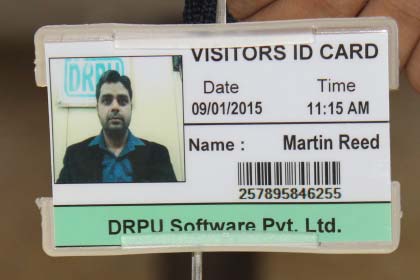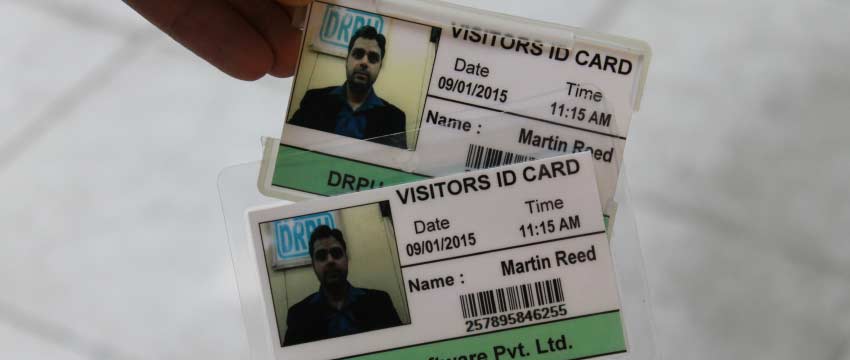Date: 13/07/2023
Can Visitor ID Cards be Integrated with other Security or Access Control Systems
Yes, visitor ID cards can be integrated with other security or access control systems to enhance overall security and streamline visitor management processes. Here are some ways visitor ID cards can be integrated::

-
Access Control Systems:
Visitor ID cards can be integrated with access control systems to regulate and monitor entry into secure areas. When a visitor presents their ID card at an access control point, such as a card reader or turnstile, the system can verify their credentials and grant or deny access accordingly. Integration ensures that visitor access privileges are synchronized with the access control system, allowing for efficient and controlled entry.
-
Security Systems:
Visitor ID cards can be integrated with various security systems to enhance overall security measures. For example, ID cards can be linked to video surveillance systems, enabling security personnel to visually verify the identity of visitors before granting access. Integration with alarm systems can also trigger alerts or notifications if unauthorized access attempts or breaches occur.
-
Visitor Management Systems:
Visitor ID cards can be integrated with visitor management systems, which are software solutions designed to manage and track visitor information. The ID card acts as a unique identifier that links to the visitor's profile in the system. Integration allows for seamless data exchange between the ID card and the visitor management system, enabling features such as pre-registration, check-in/check-out processes, badge printing, and automated record-keeping.
-
Identity Verification Systems:
Visitor ID cards can be integrated with identity verification systems, such as biometric scanners or document readers, to enhance the accuracy and reliability of visitor identification. Integration with these systems allows for additional layers of identity verification, such as fingerprint or facial recognition, to ensure that the person presenting the ID card is the authorized visitor.
-
Database Integration:
Visitor ID cards can be integrated with existing databases or directories to streamline the visitor registration process. Integration allows for automatic data retrieval and population of visitor information, reducing manual data entry and improving data accuracy. It also enables real-time updating of visitor records, ensuring that the information is current and accessible to relevant personnel.
-
Emergency Response Systems:
In emergency situations, visitor ID cards can be integrated with emergency response systems to aid in evacuation or crisis management. The ID cards can contain information about the visitor's location, assigned assembly points, or emergency contact details. Integration ensures that this information is readily available to responders, facilitating an efficient and coordinated response.
Integrating visitor ID cards with other security or access control systems provides a holistic approach to visitor management, enhances security measures, and improves operational efficiency. The specific integration capabilities will depend on the compatibility and functionality of the systems involved, as well as any applicable regulations or requirements.
Are There any Legal or Regulatory Requirements for Visitor ID Cards
Some common considerations and guidelines that are often taken into account when implementing visitor ID card systems:-
-
Privacy and Data Protection: Visitor ID cards may involve the collection and processing of personal information. Therefore, it is essential to comply with relevant privacy and data protection laws. This typically includes obtaining informed consent from visitors regarding the collection and use of their personal data, ensuring secure storage of the information, and implementing measures to protect against unauthorized access or disclosure.
-
Security and Access Control: Visitor ID cards are often used to enhance security and control access to certain areas. Depending on the nature of the facility or organization, there may be specific regulations governing the implementation of access control systems. These regulations may include guidelines for the issuance, use, and retention of ID cards, as well as requirements for visitor registration, screening, or background checks.
-
Identity Verification: Visitor ID cards are typically used to verify the identity of individuals entering a premises or participating in an event. Depending on the context, there may be legal requirements for verifying the identity of visitors, such as checking identification documents or verifying their credentials against a database of known individuals.
-
Card Design and Information: Regulations may specify certain requirements for the design and content of visitor ID cards. This can include the use of specific colors, logos, or symbols to indicate visitor status, as well as the inclusion of certain information on the card, such as the visitor's name, photo, address, date of issuance, and expiration date.
-
Visitor Records and Reporting: Depending on the nature of the organization or facility, there may be legal requirements for maintaining visitor records and reporting visitor information to relevant authorities. These requirements are often in place to facilitate security and compliance monitoring, as well as to aid in investigations if necessary.
-
Industry-Specific Regulations: Certain industries or sectors, such as healthcare, transportation, education, or government agencies, may have specific regulations governing visitor ID cards. These regulations can vary widely and may include additional requirements related to confidentiality, health and safety, or specialized access control measures.
It's important to note that the specific legal and regulatory requirements for visitor ID cards can vary significantly across different jurisdictions and contexts. It is advisable to consult with legal experts or regulatory authorities in your specific area to ensure compliance with applicable laws and regulations.
Can Visitor ID Cards be Created and Managed Electronically
Yes, visitor ID cards can be created and managed electronically. These systems provide a digital approach to managing visitor information, streamlining the visitor registration process, and enhancing security.

-
Registration:
When a visitor arrives at a facility, they are required to register their details. This can be done using self-service kiosks, tablets, or web-based portals. The visitor is prompted to enter their name, contact information, purpose of visit, and other relevant details.
-
Identification:
To verify the visitor's identity, the system may ask for additional information such as a government-issued ID or a scanned image of the visitor's identification document. This helps ensure that the visitor is who they claim to be.
-
Badge Printing:
Once the visitor's information is entered and verified, the system can generate an electronic ID card or visitor badge. This badge can include the visitor's name, photo, visitation details, and a unique identifier. The ID card can be printed on-site using dedicated badge printers or sent electronically to the visitor's mobile device.
-
Access Control:
In some cases, the electronic visitor ID card may also serve as an access control credential. The card can be programmed to grant limited access to certain areas of the facility based on the visitor's purpose or clearance level. This can be achieved through integration with existing access control systems.
-
Monitoring and Tracking:
The electronic visitor management system maintains a centralized database of visitor information. This enables administrators to track and monitor visitor activity in real-time. The system can provide insights such as the number of visitors on-site, their duration of stay, and the areas they accessed. This information can be valuable for security purposes, emergency management, or generating visitor reports.
-
Integration:
Electronic visitor ID card systems can integrate with other systems within the organization. For example, they can connect with employee directories, allowing hosts to receive automatic notifications when their visitors arrive. Integration with watchlists or databases can also help identify and flag potential security risks or banned individuals.
-
Enhanced Security:
By digitizing the visitor management process, organizations can improve security measures. Electronic ID cards can include security features such as barcodes, QR codes, or RFID technology, making it easier to verify authenticity. Additionally, the system can run visitor background checks against databases, perform watchlist screenings, or issue temporary access credentials as needed.
-
Analytics and Reporting:
Electronic visitor management systems often provide analytics and reporting capabilities. Administrators can generate reports on visitor patterns, peak visiting hours, frequent visitors, or other relevant metrics. These insights can help optimize facility management and resource allocation.
In summary, electronic visitor ID card systems offer a convenient and efficient way to manage visitor registration, identification, and access control. They enhance security, provide real-time monitoring, and streamline administrative tasks, ultimately improving the overall visitor experience.